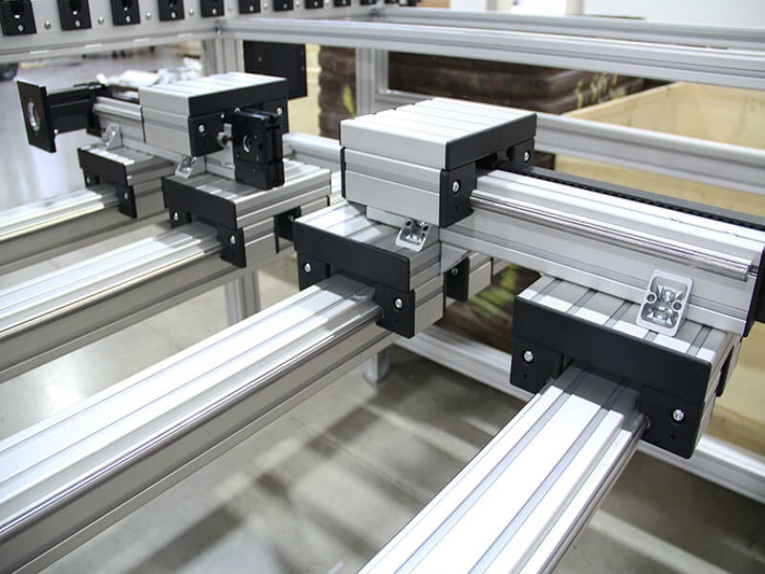Belt driven, Ball screw driven, Rack and pinion driven, Linear motor driven, Pneumatic driven systems.
Gone are the days when machine designers and builders had to choose between constructing their own linear system from scratch or settling for a limited range of pre-assembled systems that, in most cases, were an imperfect fit for their application. Manufacturers today offer systems based on a range of drive mechanisms—ball screws, belts, rack and pinions, linear motors, and pneumatics—with guide and housing options to fit virtually any application, environment, or space constraint. The dilemma for engineers now is less about finding a system that will work for their application, and more about choosing the best solution from the wide range of available configurations.
Many aides have been created to help with this selection process. These typically take the form of a table showing key application parameters versus system type, with symbols to rate the suitability of each system for each parameter. While this layout provides a quick, visual reference, it misses some of the finer points of each system’s abilities and weaknesses. In an attempt to dig a little deeper, the following outline looks at the specific strengths and limitations of the most common types of pre-assembled linear systems.
Belt driven systems
Belt drive systems are probably best recognized for their ability to travel long lengths. They’re also able to achieve high speeds, since belt drive mechanisms do not use recirculating elements. When paired with non-recirculating guides, such as cam rollers or wheels, belts can typically achieve speeds up to 10 m/s. Belt driven systems are also well suited for harsh environments, since there are no rolling elements to be damaged by debris, and the polyurethane belt material can withstand most common types of chemical contamination.
The primary drawback of belt driven systems is that belts stretch. Even steel-reinforced belts, which are used by most system manufacturers, will eventually experience some stretch, which degrades repeatability and travel accuracy. Belt driven systems also have more resonance than other types of drives, due to the elasticity of the belt. While proper drive tuning can compensate for this, applications with high acceleration and deceleration rates and/or heavy loads may experience undesirable settling times.
Ball screw driven systems
For high thrust loads and high positioning accuracy, ball screw driven systems are generally the first choice. And for good reason. With preloaded nuts, ball screws provide backlash-free motion and can achieve very high positioning accuracy and repeatability. Leads ranging from 2mm to 40+ mm, also allow ball screw systems to meet a wide range of speed requirements and can prevent backdriving in vertical applications.
Travel length is the fundamental limitation of ball screw driven systems. As the length of the screw increases, the permissible speed decreases, due to the tendency of the screw to sag under its own weight and experience whipping. Ball screw supports can help counter this effect, but at the expense of space and overall system cost.
Rack and pinion driven systems
Rack and pinion systems produce high thrust forces and can do so with virtually unlimited travel lengths. Their design also allows multiple carriages to be used on the same system, which is useful for applications that require carriages to move independently, such as large gantry systems in the packaging and automotive industries.
While high-quality, low-backlash rack and pinion systems are available, in general, they have lower positioning accuracy than other drive options. And depending on the tooth profile and quality of machining, rack and pinion driven systems can produce a high level of noise when compared to other linear systems.
Linear motor driven systems
Traditionally regarded as too expensive for most applications, linear motors are now being used for positioning and handling tasks in industries such as packaging and assembly. Lower costs have contributed to this trend, but for engineers, the appealing characteristics of linear motors are their high speed capability, high positioning accuracy, and low maintenance requirements. Linear motors also offer the ability, like rack and pinion systems, to integrate multiple, independent carriages on one system.
Because they have no mechanical components to prevent the load from falling in a loss-of-power condition, linear motors are generally not advised for use in vertical applications. Their open design, together with the presence of powerful magnets, also makes them susceptible to contamination and debris, especially metal chips and shavings.
Pneumatic driven systems
When the preferred power transmission source is air, pneumatic linear systems fit the bill. For simple, point-to-point motion, pneumatic driven systems can be the most economical and simple-to-integrate option. Most pneumatic linear systems are enclosed in an aluminum housing, which allows end dampers and protective covers to be incorporated.
Pneumatic systems have the lowest precision and rigidity of the types discussed here, but their main limitation is the inability to stop at intermediate positions.
Regardless of your application, when considering the options among pre-assembled linear systems, start with the four primary application parameters—stroke, load, speed, and precision. Once the magnitude and importance of these criteria are determined, other parameters, such as noise, rigidity, and environmental factors, can help narrow the field and make final sizing and selection less time-consuming.
Post time: Oct-19-2020








